Whirlpool WRS970CIHZ, WRSA71CIHZ, WRS571CIHV, WRS571CIHW, WRS571CIHB Installation Guide
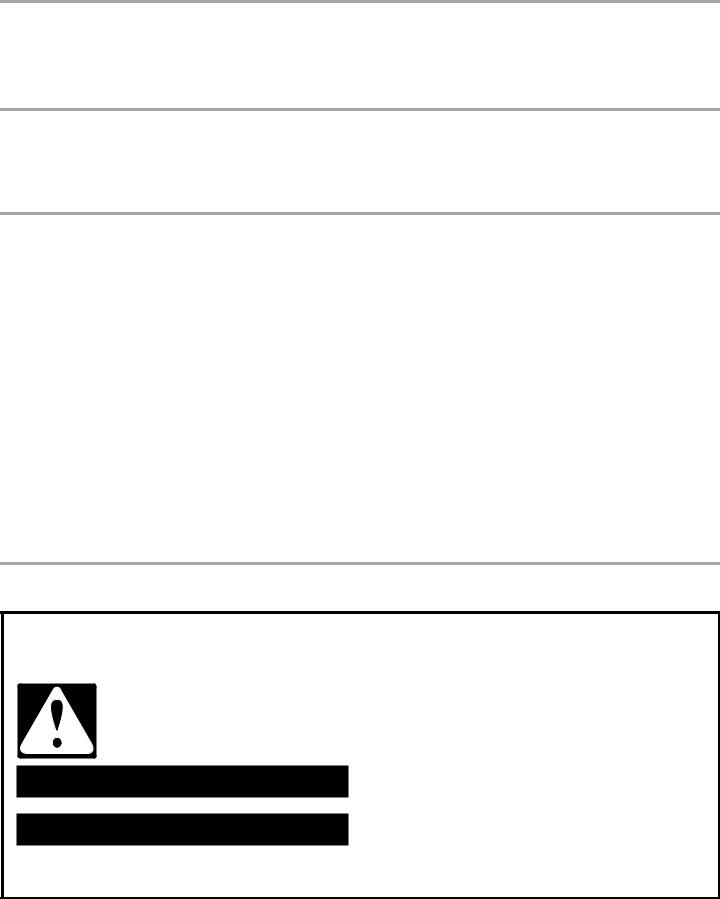
INSTALLATION INSTRUCTIONSAND OWNER’S MANUAL
SidebySideRefrigerator
Do Not Throw Away — Additional important safety information included.
Para las instrucciones en español, visite nuestro sitio de internet.
INSTRUCTIONSD’INSTALLATION ET MANUEL D’UTILISATION
Réfrigérateurcôteà côte
Ne pas jeter — Autres consignes de sécurité importantes ci-jointes.
Tableof Contents/ Tabledesmatières
REFRIGERATOR SAFETY..................................................................... |
1 |
Proper Disposal of Your Old Refrigerator........................................... |
2 |
INSTALLATION INSTRUCTIONS ......................................................... |
2 |
Unpack the Refrigerator...................................................................... |
2 |
Door Removal, Leveling and Alignment ............................................. |
3 |
Handle Installation and Removal ........................................................ |
6 |
Location Requirements....................................................................... |
7 |
Electrical Requirements ...................................................................... |
7 |
Water Supply Requirements............................................................... |
7 |
Connect Water Supply........................................................................ |
8 |
FILTERS AND ACCESSORIES ........................................................... |
10 |
Install Air Filter................................................................................... |
10 |
Install Produce Preserver.................................................................. |
11 |
Changing the Water Filter ................................................................. |
12 |
REFRIGERATOR CARE....................................................................... |
12 |
Cleaning ............................................................................................ |
12 |
Lights................................................................................................. |
13 |
Vacation and Moving Care ............................................................... |
14 |
PROBLEM SOLVER............................................................................. |
15 |
WATER FILTER CERTIFICATIONS .................................................... |
19 |
PERFORMANCE DATA SHEET.......................................................... |
20 |
SÉCURITÉ DU RÉFRIGÉRATEUR ..................................................... |
21 |
Mise au rebut appropriée de votre vieux réfrigérateur..................... |
22 |
INSTRUCTIONS D'INSTALLATION ................................................... |
22 |
Déballage du réfrigérateur ................................................................ |
22 |
Retrait, réglage de l'aplomb et alignement des portes.................... |
23 |
Installation et démontage des poignées .......................................... |
26 |
Exigences d'emplacement ............................................................... |
27 |
Spécifications électriques................................................................. |
28 |
Spécifications de l’alimentation en eau............................................ |
28 |
Raccordement de la canalisation d'eau........................................... |
29 |
FILTRES ET ACCESSOIRES............................................................... |
31 |
Installation du filtre à air.................................................................... |
31 |
Installation du sachet de conservation pour produits frais.............. |
32 |
Changer le filtre à eau....................................................................... |
33 |
ENTRETIEN DU RÉFRIGÉRATEUR ................................................... |
34 |
Nettoyage.......................................................................................... |
34 |
Lampes ............................................................................................. |
34 |
Entretien avant les vacances ou lors d’un déménagement ............. |
36 |
RÉSOLUTION DE PROBLÈMES ........................................................ |
37 |
FEUILLE DE DONNÉES SUR LA PERFORMANCE.......................... |
43 |
REFRIGERATORSAFETY
Your safety and the safety of others are very important.
many important safety messages in this manual and on your appliance. Always read and obey all safety
safety alert symbol.
alerts you to potential hazards that can kill or hurt you and others.
messages will follow the safety alert symbol and either the word “DANGER” or “WARNING.” mean:
 DANGER
DANGER  WARNING
WARNING
You can be killed or seriously injured if you don't immediately follow instructions.
You can be killed or seriously injured if you don't follow instructions.
All safety messages will tell you what the potential hazard is, tell you how to reduce the chance of injury, and tell you what can happen if the instructions are not followed.
W10706411B
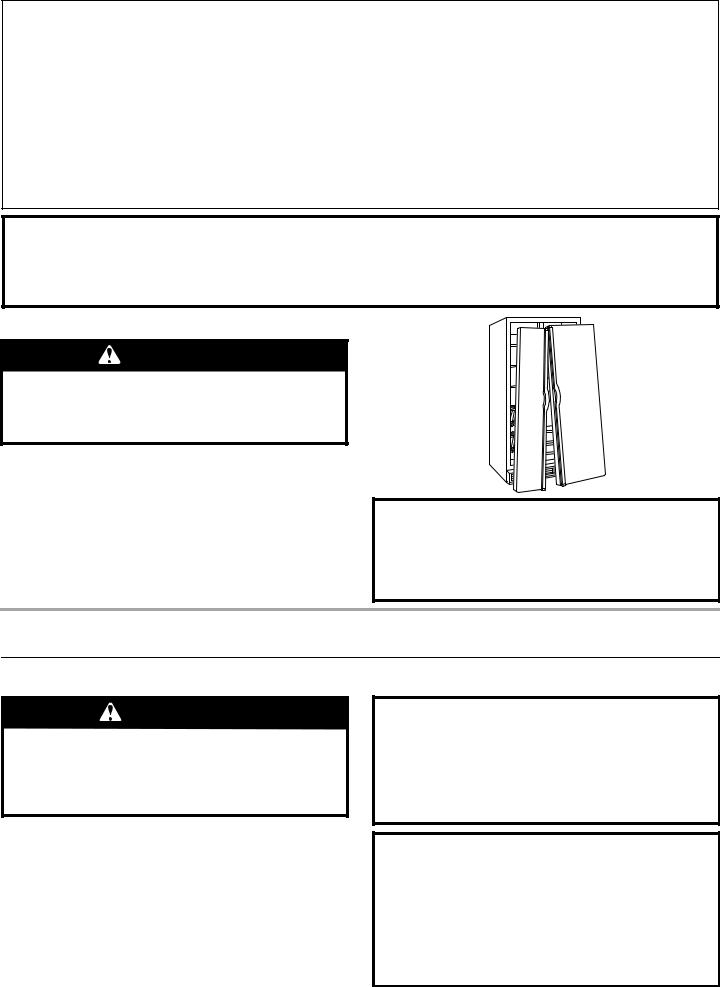
IMPORTANT SAFETY INSTRUCTIONS
WARNING: To reduce the risk of fire, electric shock, or injury when using your refrigerator, follow these basic precautions: ■ Use nonflammable cleaner.
■ Keep flammable materials and vapors, such as gasoline, away from refrigerator.
■ Use two or more people to move and install refrigerator.
■ Disconnect power before installing ice maker (on ice maker kit ready models only).
■ Use a sturdy glass when dispensing ice (on some models). ■ Do not hit the refrigerator glass doors (on some models).
SAVE THESE INSTRUCTIONS
State of California Proposition 65 Warnings:
WARNING: This product contains one or more chemicals known to the State of California to cause cancer.
WARNING: This product contains one or more chemicals known to the State of California to cause birth defects or other reproductive harm.
Proper Disposal of Your Old Refrigerator
WARNING
Suffocation Hazard
Remove doors from your old refrigerator.
Failure to do so can result in death or brain damage.
IMPORTANT: Child entrapment and suffocation are not problems of the past. Junked or abandoned refrigerators are still dangerous, even if they will sit for “just a few days.” If you are getting rid of your old refrigerator, please follow these instructions to help prevent accidents.
Before You Throw Away Your Old Refrigerator or Freezer:
■Take off the doors.
■Leave the shelves in place so that children may not easily climb inside.
Important information to know about disposal of refrigerants:
Dispose of refrigerator in accordance with Federal and Local regulations. Refrigerants must be evacuated by a licensed, EPA certified refrigerant technician in accordance with established procedures.
INSTALLATION INSTRUCTIONS
Unpack the Refrigerator
WARNING
Excessive Weight Hazard
Use two or more people to move and install refrigerator.
Failure to do so can result in back or other injury.
Remove packaging materials. Do not use sharp instruments, rubbing alcohol, flammable fluids, or abrasive cleaners to remove tape or glue. These products can damage the surface of your refrigerator. For more information, see “Refrigerator Safety.”
2
When Moving Your Refrigerator:
Your refrigerator is heavy. When moving the refrigerator for cleaning or service, be sure to cover the floor with cardboard or hardboard to avoid floor damage. Always pull the refrigerator straight out when moving it. Do not wiggle or “walk” the refrigerator when trying to move it, as floor damage could occur.
Important information to know about glass shelves and covers:
Do not clean glass shelves or covers with warm water when they are cold. Shelves and covers may break if exposed to sudden temperature changes or impact, such as bumping. Tempered glass is designed to shatter into many small, pebble-size pieces. This is normal. Glass shelves and covers are heavy. Use both hands when removing them to avoid dropping.
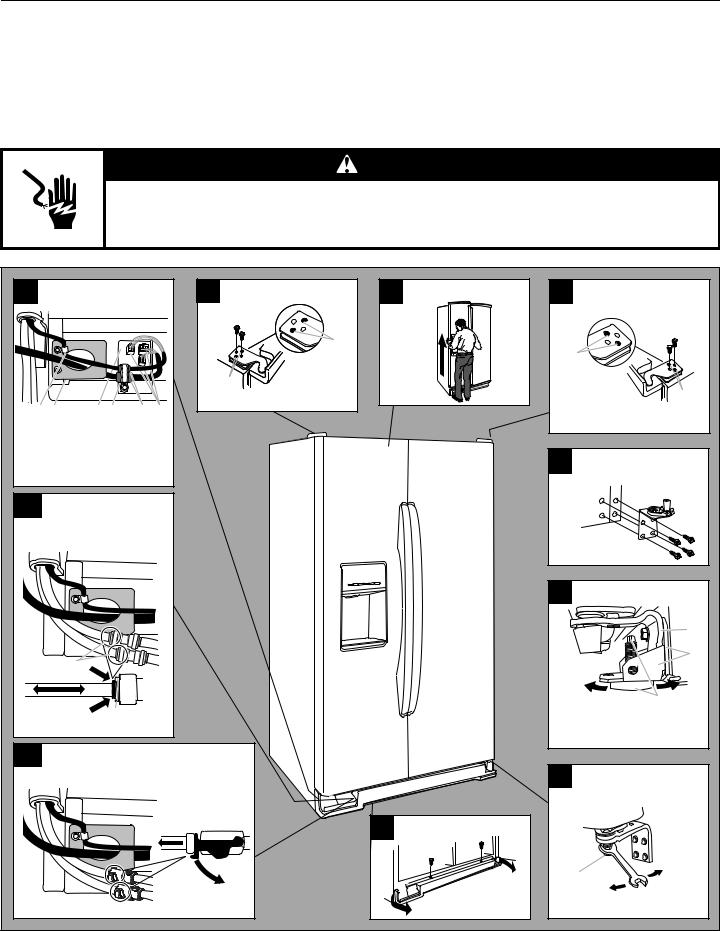
Door Removal, Leveling and Alignment
Gather the required tools and parts and read all instructions before starting installation. Save these instructions for future reference. IMPORTANT: The graphics on this page are for models with the ice storage bin on the door. On models with the ice storage bin inside the freezer, the wiring and water dispenser tubing configurations are simpler than what is shown in these graphics. Please read all instructions on the next few pages for more information.
NOTE: Before moving your product into your home, measure the doorway of your home to see whether you need to remove the refrigerator and freezer doors. If door removal is necessary, see the instructions below.
IMPORTANT: Before you begin, turn the refrigerator control OFF or turn cooling off. Unplug refrigerator or disconnect power. Remove food, the ice storage bin (on some models), and any adjustable door or utility bins from doors.
 WARNING
WARNING
Electrical Shock Hazard
Disconnect power before removing doors.
Failure to do so can result in death or electrical shock.
3 |
Wiring Connection |
4 |
Top Left Hinge |
5 |
Door Removal |
6 |
Top Right Hinge |
||||
|
|
|
|
|
|
A |
|
|
|
|
|
|
|
|
|
|
|
|
|
|
|
A |
|
|
|
|
|
|
|
A |
|
|
|
|
|
|
|
|
|
|
A. Do Not Remove Screws. |
|
|
|
|
A |
|
A |
B |
C D |
E |
F |
|
|
|
|
A. Do Not Remove Screws. |
||
A. P-clamp |
D. Wiring Clip |
|
|
|
|
||||||
|
|
|
|
|
|
|
|||||
B. Routing |
E. Grommets |
|
|
|
|
|
|
|
|||
Plate |
F. Wiring |
|
|
|
|
|
7 |
Bottom Hinges |
|||
C. Electrical |
Plugs |
|
|
|
|
|
|||||
Housing |
|
|
|
|
|
|
|
|
(Left and Right) |
||
2A Water Dispenser |
|
|
|
|
|
|
|
|
|||
|
Tubing Connection |
|
|
|
|
|
|
|
|||
|
(Style 1) |
|
|
|
|
|
|
|
|
|
|
|
|
|
|
|
|
|
|
|
8 |
Leveling |
|
|
|
|
|
|
|
|
|
|
|
|
A |
|
|
|
|
|
|
|
|
|
|
|
B |
|
A |
|
|
|
|
|
|
|
|
|
|
|
|
|
|
|
|
|
|
|
Raise |
Lower |
|
|
|
|
|
|
|
|
|
|
|
C |
|
|
|
A |
|
|
|
|
|
|
|
A. Bottom Hinge |
|
|
|
|
|
|
|
|
|
|
B. Leveler Bracket |
||
|
A. Face of Fitting |
|
|
|
|
|
|
|
|||
|
|
|
|
|
|
|
|
C. Leveling Foot |
|
||
|
|
|
|
|
|
|
|
|
|
|
|
2B Water Dispenser Tubing |
|
|
|
|
|
|
|
||||
|
Connection (Style 2) |
|
|
|
|
9 |
Door Alignment |
||||
|
|
|
|
|
|
|
|
|
|
(Bottom Right Hinge) |
|
|
|
|
|
|
|
|
1 |
Base Grille |
|
|
|
|
|
|
|
|
|
|
|
|
|
A |
Raise |
|
|
|
|
|
|
|
|
Doors must be |
|
Lower |
|
|
|
|
|
|
|
|
|
|
A. Alignment Screw |
||
|
|
|
|
|
|
|
|
open to 90˚ |
|
||
|
|
|
|
|
|
|
|
|
|
|
|
|
|
|
|
|
|
|
|
|
|
|
3 |
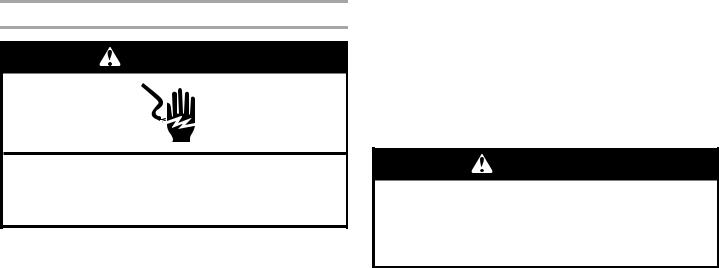
TOOLS NEEDED:
Bubble level, Phillips screwdriver, ³⁄ " hex key, ¹⁄ " hex-head socket wrench, ¹⁄ " and ⁄ " open-ended wrenches or adjustable wrench, internal star drive or ³⁄ " hex-head socket wrench
Remove the Doors
WARNING
Hazard
Disconnect power before removing doors.
Failure to do so can result in death or electrical shock.
1.Unplug refrigerator or disconnect power.
2.Open both doors to 90°. Remove the base grille by removing the two screws, then pulling out on the outside corners. See Graphic 1.
NOTE: The doors must only be opened to 90°. If they are opened all the way, the base grille will not come off.
3.Disconnect the water tubing, located behind the base grille on the freezer door side. The dispenser tubing runs through the door hinge, and must be disconnected in order to remove the door.
NOTE: On models with the ice storage bin on the door, there are two water tubing connections, as shown. On models with the ice storage bin inside the freezer, there is only one water tubing connection.
■Style 1: Press the colored outer ring against the face of fitting and pull the water tubing free. See Graphic 2A.
NOTE: Keep the water tubing connector attached to the tube that runs underneath the freezer. The door cannot be removed if the connector is still attached to the tube that runs through the door hinge.
■Style 2: Firmly pull on the clasp to release the tube, then pull the water tubing free. See Graphic 2B.
NOTE: Keep the clasp attached to the tube that runs underneath the freezer.
4.Disconnect the wiring, located behind the base grille on the freezer door side. See Graphic 3.
On models with the ice storage bin on the door:
NOTE: There are two wiring bundles that run underneath the freezer - a large bundle with a large grommet and two white plugs at the end, and a small bundle with a small grommet and one yellow plug at the end.
■Remove the P-clamp using a ¹⁄ " hex-head socket wrench. Remove the small wiring bundle from the P-clamp.
■Remove the wiring clip using a ¹⁄ " hex-head socket wrench.
■Pull the electrical housing out from under the refrigerator. Disconnect the wiring plugs from the housing.
■Gently pull the large wiring bundle (with two white plugs) through the routing plate.
4
On models with the ice storage bin inside the freezer:
NOTE: The wiring configuration is simpler than what is shown in Graphic 3. There is only one wiring bundle with one wiring plug, and there is not a routing plate.
■Remove the wiring clip using a ¹⁄ " hex-head socket wrench.
■Pull the electrical housing out from under the refrigerator. Disconnect the wiring plug from the housing.
5.Close both doors and keep them closed until you are ready to lift them free from the cabinet.
6.Use a ³⁄ " hex key to remove the top left hinge screws as shown. See Graphic 4.
IMPORTANT: Do not remove either screw A.
WARNING
Excessive Weight Hazard
Use two or more people to lift the freezer door. Failure to do so can result in back or other injury.
7.Lift freezer door straight up off bottom hinge. See Graphic 5. The water tubing and wiring remain attached to the freezer door and pull through the bottom left hinge.
NOTE: This may require two people - one to lift the door and another to feed the water tubing and wiring through the hinge.
On models with the ice storage bin on the door:
■Be sure the hole in the hinge is clear of obstructions, then gently pull one water tube through the hinge. (Avoid kinking the tube.) Next, gently pull the other water tube through the hinge, again avoiding kinks. Finally, gently pull the wiring bundle (including the grommet and wiring plugs) through the hinge.
On models with the ice storage bin inside the freezer:
■Be sure the hole in the hinge is clear of obstructions, then gently pull the water tube through the hinge. (Avoid kinking the tube.) Next, gently pull the wiring bundle (including the grommet and wiring plug) through the hinge.
IMPORTANT: Rest the door on its side on a soft, clean surface, such as a towel, blanket or piece of cardboard. This will help avoid damaging the door, water tubing and wiring.
8.Use a ³⁄ " hex key to remove the top right hinge screws as shown. See Graphic 6.
IMPORTANT: Do not remove either screw A.
9.Lift the refrigerator door straight up off bottom hinge.
IMPORTANT: Rest the door on its side on a soft, clean surface, such as a towel, blanket or piece of cardboard. This will help avoid damaging the door.
10.It may not be necessary to remove the bottom hinges to move the refrigerator through a doorway. Both bottom hinges have similar construction.
■If necessary, use an internal star drive or a ³⁄ " hex-head socket wrench to remove the bottom hinges. See Graphic 7.
IMPORTANT: The leveler brackets are mounted behind the hinges. If you remove the hinges, make sure that the leveler brackets are replaced when reinstalling the hinges.
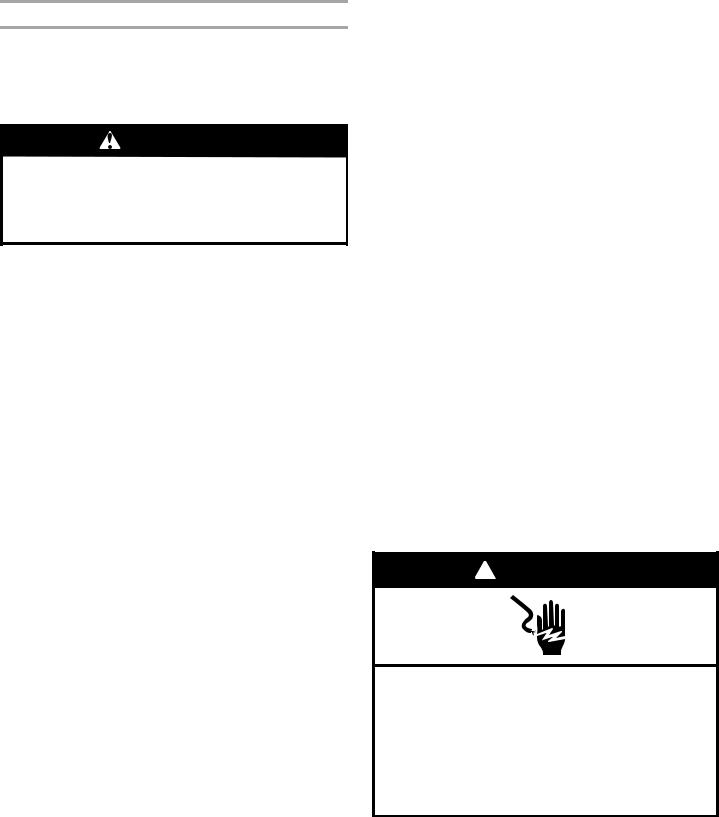
Replace the Doors and Hinges
1.Replace both bottom hinges, if removed. Make sure that the leveler brackets are assembled behind the hinges. Tighten screws.
IMPORTANT: When the screws are tightened properly, there should not be any gaps between the refrigerator, leveler bracket and hinge.
WARNING
Excessive Weight Hazard
Use two or more people to lift the freezer door. Failure to do so can result in back or other injury.
2.Before replacing the freezer door on the bottom left hinge, feed the wiring and water tubing through the hinge.
On models with the ice storage bin on the door:
■Feed the small wiring bundle through the hinge. Assistance may be needed.
IMPORTANT: Do not feed the large wiring bundle through the hinge. This bundle is intended to run directly from the door to the connections beneath the freezer. Forcing the large bundle through the hinge may damage the door and/or the wiring, and will keep the door from closing properly.
■Feed both water tubes through the bottom left hinge, then replace the freezer door on the hinge. Assistance may be needed.
On models with the ice storage bin inside the freezer:
■Feed the wiring bundle through the hinge. Assistance may be needed.
■Feed the water tube through the bottom left hinge, then replace the freezer door on the hinge. Assistance may be needed.
NOTE: Provide additional support for the doors while the top hinges are being replaced. Do not depend on the door magnets to hold the doors in place while you are working.
3.Align and replace the top left hinge as shown. See Graphic 4. Tighten screws.
4.Reconnect water tubing and wiring.
IMPORTANT: Do not intertwine the water tubing and wiring bundles when reconnecting them.
On models with the ice storage bin on the door:
■Water Connection Style 1: Push the larger ⁄" (7.94 mm) water tube into the blue fitting until it stops, then push the smaller ¹⁄" (6.35 mm) water tube into the green fitting until it stops. See Graphic 2A.
Water Connection Style 2: Push the black water tube with the blue tip into the blue fitting until it stops. Close the clasp around the tubing, making sure it snaps into place. Repeat this process to connect the red-tipped black water tube and the red fitting. See Graphic 2B.
■Reinstall the P-clamp around the small wiring bundle (with one yellow plug), then replace the P-clamp on the top screw hole of the routing plate. See Graphic 3.
■Gently route the large wiring bundle (with two white plugs) through the hole in the routing plate, so that the wiring runs behind the right side of the routing plate. See Graphic 3.
NOTE: The large wiring bundle should always remain below the small wiring bundle.
■Reconnect the wiring plugs to the electrical housing, then push the housing back under the refrigerator. Align the left hole in the front lip of the housing with the right hole in the refrigerator's base crossbar. See Graphic 3.
■Reinstall the wiring clip over the grommets. First install the smaller grommet into the top of the clip, then install the larger grommet into the bottom of the clip (closest to the screw hole). See Graphic 3.
■Align the clip's screw hole with the left hole in the electrical housing and the right hole in the crossbar, and screw in the clip using a single screw. Tighten screw. See
Graphic 3.
IMPORTANT: Once connected, the wiring bundles should not be taut. Some flexibility is needed to allow the freezer door to open properly.
On models with the ice storage bin inside the freezer:
■Water Connection Style 1: Push the water tube into the fitting until it stops. See Graphic 2A.
Water Connection Style 2: Push the water tube into the fitting until it stops. Close the clasp around the tubing, making sure it snaps into place. See Graphic 2B.
■Reconnect the wiring plug to the electrical housing, then push the housing back under the refrigerator. Align the left hole in the front lip of the housing with the right hole in the refrigerator's base crossbar. See Graphic 3.
■Reinstall the wiring clip over the grommet. See Graphic 3.
■Align the clip's screw hole with the left hole in the electrical housing and the right hole in the crossbar, and screw in the clip using a single screw. Tighten screw. See
Graphic 3.
IMPORTANT: Once connected, the wiring should not be taut. Some flexibility is needed to allow the freezer door to open properly.
5.Replace the refrigerator door by lifting the door onto the bottom right hinge.
6.Align and replace the top right hinge as shown. See Graphic 6. Tighten screws.
7.Replace the ice storage bin (on some models) and any adjustable door or utility bins.
 WARNING
WARNING
Electrical Shock Hazard
Plug into a grounded 3 prong outlet.
Do not remove ground prong.
Do not use an adapter.
Do not use an extension cord.
Failure to follow these instructions can result in death, fire, or electrical shock.
8. Plug refrigerator into a grounded 3 prong outlet.
5
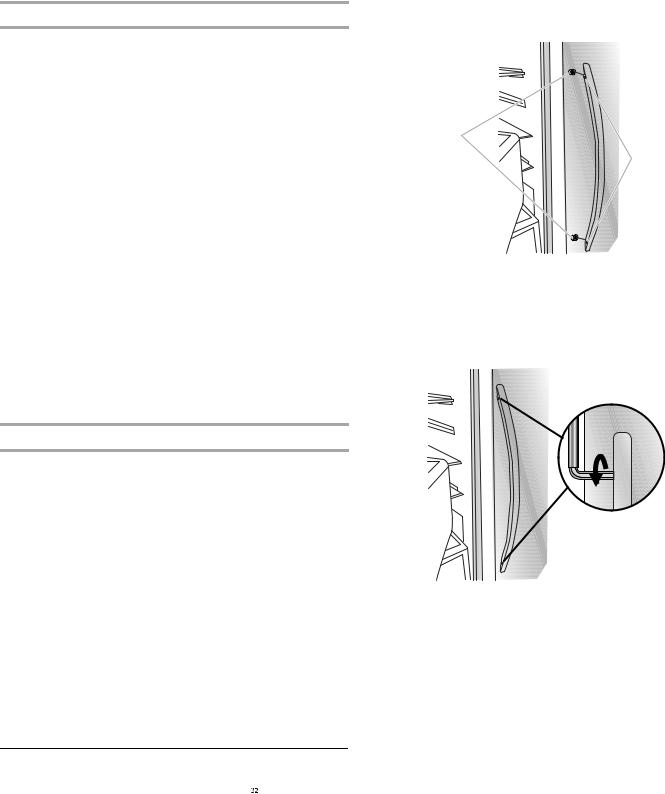
Leveling and Door Closing
Your refrigerator has two adjustable front feet — one on the right and one on the left. In most cases, the refrigerator should be steady when both feet are touching the floor. If your refrigerator seems unsteady or if you want the doors to close more easily, adjust the refrigerator's tilt using the instructions below:
1.Move the refrigerator into its final location. If necessary, open both doors to 90° and remove the base grille. See Graphic 1.
2.The two leveling feet are located on the brackets on each side of the product. See Graphic 8.
NOTE: Having someone push against the top of the refrigerator takes some weight off the leveling feet. This makes it easier to make adjustments.
3.Use a ¹⁄" open-ended or adjustable wrench to adjust the leveling feet. Turn the leveling foot to the left to raise that side of the product, or turn it to the right to lower that side of the product.
NOTE: Both leveling feet should be snug against the floor, and the rollers should not touch the floor. This keeps the refrigerator from rolling forward when opening the doors.
4.Open both doors again and check that they close as easily as you like. If not, tilt the refrigerator slightly more to the rear by turning the leveling feet to the left. It may take several more turns, and you should turn both leveling feet the same amount.
5.Use a bubble level to check the leveling of the refrigerator.
NOTE: Whenever you need to move the refrigerator, turn the leveling feet to the right until they are no longer touching the ground. This will allow the refrigerator to roll more easily.
Door Alignment
A refrigerator that is not level from side-to-side may appear to have doors that are not properly aligned. If the doors appear this way, use the instructions in the previous section to check the leveling.
The doors are designed to be slightly different heights when the refrigerator is empty, in order to account for the weight of food that will be placed on the doors. If the doors are still not aligned after checking the leveling and loading the refrigerator with food, follow the steps below to adjust the door alignment.
1.If necessary, open both doors to 90° and remove the base grille. See Graphic 1.
2.Locate the alignment screw on the bottom hinge of the refrigerator door. See Graphic 9.
3.Use a ⁄" open-ended or adjustable wrench to turn the screw. To raise the refrigerator door, turn the screw to the right. To lower the door, turn the screw to the left.
4.Check that the doors are even at the top. If necessary, continue to turn the alignment screw until the doors are aligned.
5.Open both doors to 90°. Replace the base grille. See Graphic 1.
HandleInstallationand Removal
PARTS INCLUDED: Door handles (2), ¹⁄" and ³⁄ " hex key as needed, spare setscrew(s).
To Install the Handles:
NOTE: The handle mounting setscrews are preinstalled in the handle.
1.Remove the handles, which are packed inside the refrigerator.
NOTE: To avoid scratching the finish, place the handles on a towel or other soft surface.
2.Open the freezer door. On the refrigerator door, place the handle on the shoulder screws with the setscrews facing the freezer.
A
B
A.Shoulder screws
B.Setscrews inside the handle
3.Firmly push the handle toward the door until the handle base is flush against the door.
4.While holding the handle, insert the short end of the hex key into the upper hole and slightly rotate the hex key until it is engaged in the setscrew.
5.Using a clockwise motion, tighten the setscrew until it begins to contact the shoulder screw.
6.Repeat steps 4 and 5 to begin fastening the lower setscrew.
7.Once both setscrews have been partially tightened as outlined in the previous steps, fully tighten both the upper and lower setscrews.
IMPORTANT: When the screws feel tight, tighten them an additional quarter-turn. The handle is not properly installed without this extra tightening.
8.Open the refrigerator door and close the freezer door. Repeat steps 2 through 7 to install the other handle onto the freezer door with the setscrews facing the refrigerator.
9.Save the hex key and all instructions.
To Remove the Handles:
1.While holding the handle, insert the short end of the hex key into the lower setscrew hole and slightly rotate the hex key until it is engaged in the setscrew.
2.Using a counterclockwise motion, loosen the setscrew a quarter-turn at a time.
3.Repeat steps 1 and 2 for the upper setscrew. Gently pull the handle away from the door.
4.If necessary, use a Phillips screwdriver to remove the shoulder screws from the door.
6
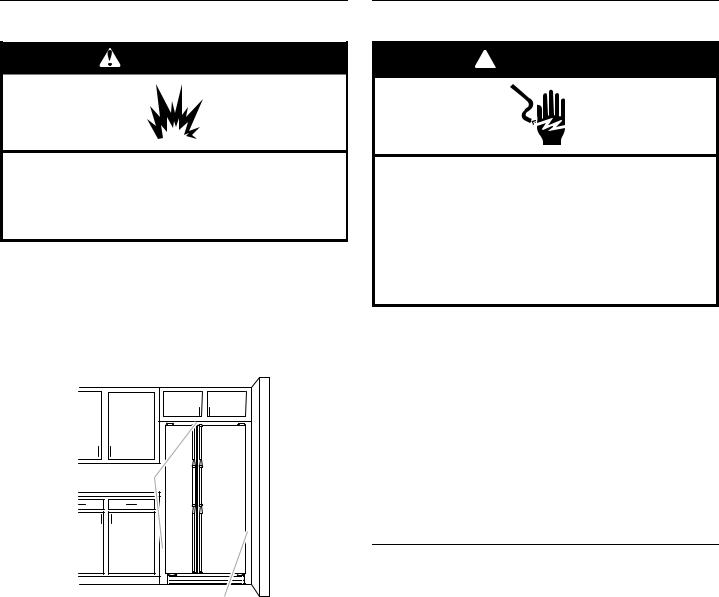
Location Requirements
WARNING
Explosion Hazard
Keep flammable materials and vapors, such as gasoline, away from refrigerator.
Failure to do so can result in death, explosion, or fire.
IMPORTANT: This refrigerator is designed for indoor household use only.
To ensure proper ventilation for your refrigerator, allow for ¹⁄ " (1.27 cm) of space on each side and at the top. Allow for 1" (2.54 cm) of space behind the refrigerator. If your refrigerator has an ice maker, allow extra space at the back for the water line connections. When installing your refrigerator next to a fixed wall, leave a 2" (5.08 cm) minimum space on each side (depending on your model) to allow the doors to swing open.
1/2" (1.27 cm)
2" (5.08 cm)
NOTES:
■This refrigerator is intended for use in a location where the temperature ranges from a minimum of 55°F (13°C) to a maximum of 110°F (43°C). The preferred room temperature range for optimum performance, which reduces electricity usage and provides superior cooling, is between 60°F (15°C) and 90°F (32°C). It is recommended that you do not install the refrigerator near a heat source, such as an oven or radiator.
■Normal minimum cabinet cut-out width required for product installation is 36" (91.44 cm). However, if the product is placed against an extended wall and the ability to remove the crisper pans is desired, an additional 18" (45.72 cm) of cabinet width is required, so a total cabinet opening width of 54"
(137.16 cm) is recommended.
Electrical Requirements
 WARNING
WARNING
Electrical Shock Hazard
Plug into a grounded 3 prong outlet.
Do not remove ground prong.
Do not use an adapter.
Do not use an extension cord.
Failure to follow these instructions can result in death, fire, or electrical shock.
Before you move your refrigerator into its final location, it is important to make sure you have the proper electrical connection.
Recommended Grounding Method
A 115 volt, 60 Hz, AC only, 15or 20-amp fused, grounded electrical supply is required. It is recommended that a separate circuit serving only your refrigerator be provided. Use an outlet that cannot be turned off by a switch. Do not use an extension cord.
NOTE: Before performing any type of installation or cleaning, or removing a light bulb, turn cooling off or turn the control (Thermostat, Refrigerator or Freezer Control depending on the model) to OFF, and then disconnect the refrigerator from the electrical source. When you are finished, reconnect the refrigerator to the electrical source and turn cooling on or reset the control (Thermostat, Refrigerator or Freezer Control depending on the model) to the desired setting. See “Using the Controls” in the User Instructions, User Guide, or Use & Care Guide.
Water Supply Requirements
Gather the required tools and parts before starting installation. Read and follow the instructions provided with any tools listed here.
TOOLS NEEDED:
■ |
Flat-blade screwdriver |
■ |
¹⁄ " nut driver |
■ |
⁄ " and ¹⁄ " open-end or |
■ |
¹⁄ " drill bit |
|
two adjustable wrenches |
■ |
Cordless drill |
|
|
NOTE: Your refrigerator dealer has a kit available with a ¹⁄ " (6.35 mm) saddle-type shutoff valve, a union, and copper tubing. Before purchasing, make sure a saddle-type valve complies with your local plumbing codes. Do not use a piercing-type or ³⁄ "
(4.76 mm) saddle valve which reduces water flow and clogs more easily.
IMPORTANT:
■All installations must meet local plumbing code requirements.
■Use copper tubing and check for leaks. Install copper tubing only in areas where the household temperatures will remain above freezing.
7
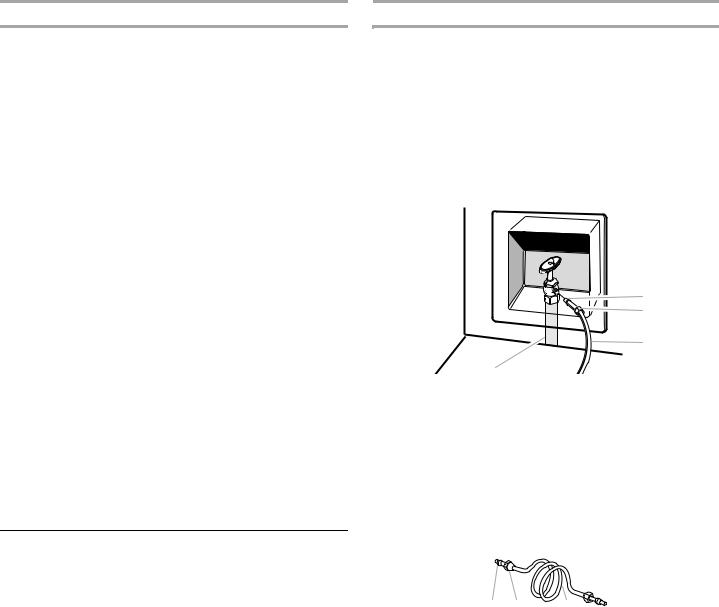
Water Pressure
A cold water supply with water pressure of between 30 and 120 psi (207 and 827 kPa) is required to operate the water
dispenser and ice maker. If you have questions about your water pressure, call a licensed, qualified plumber.
■If your refrigerator has a water dispenser: After installation is complete, use the water dispenser to check the water pressure.
■With the water filter removed, dispense 1 cup (237 mL) of water. If 1 cup of water is dispensed in 8 seconds or less, the water pressure to the refrigerator meets the minimum requirement.
■If it takes longer than 8 seconds to dispense 1 cup of water, the water pressure to the refrigerator is lower than recommended. See “Problem Solver” for suggestions.
Reverse Osmosis Water Supply
IMPORTANT: The pressure of the water supply coming out of a reverse osmosis system going to the water inlet valve of the refrigerator needs to be between 30 and 120 psi (207 and
827 kPa).
If a reverse osmosis water filtration system is connected to your cold water supply, the water pressure to the reverse osmosis system needs to be a minimum of 40 to 60 psi (276 to 414 kPa).
If the water pressure to the reverse osmosis system is less than 40 to 60 psi (276 to 414 kPa):
■Check to see whether the sediment filter in the reverse osmosis system is blocked. Replace the filter if necessary.
■Allow the storage tank on the reverse osmosis system to refill after heavy usage.
■If your refrigerator has a water filter, it may further reduce the water pressure when used in conjunction with a reverse osmosis system. Remove the water filter. See “Water Filtration System” in the User Instructions, User Guide, or Use & Care Guide.
If you have questions about your water pressure, call a licensed, qualified plumber.
Connect Water Supply
Read all directions before you begin.
IMPORTANT:
■Plumbing shall be installed in accordance with the International Plumbing Code and any local codes and ordinances.
■The gray water tubing on the back of the refrigerator (which is used to connect to the household water line) is a PEX (cross-linked polyethylene) tube. Copper and PEX tubing connections from the household water line to the refrigerator are acceptable, and will help avoid off-taste or odor in your ice or water. Check for leaks.
If PEX tubing is used instead of copper, we recommend the following Whirlpool Part Numbers:
W10505928RP (7 ft [2.14 m] jacketed PEX), 8212547RP (5 ft [1.52 m] PEX), or W10267701RP (25 ft [7.62 m] PEX).
■Install tubing only in areas where temperatures will remain above freezing.
TOOLS NEEDED:
Gather the required tools and parts before starting installation.
■Flat-blade screwdriver
■⁄ " and ¹⁄ " open-end wrenches or two adjustable wrenches
■¹⁄ " nut driver
Connect to Water Line
IMPORTANT: If you turn the refrigerator on before the water line is connected, turn the ice maker OFF.
Style 1 (Recommended)
1.Unplug refrigerator or disconnect power.
2.Turn OFF main water supply. Turn ON nearest faucet long enough to clear line of water.
3.Use a quarter-turn shutoff valve or the equivalent, served by a ¹⁄ " copper household supply line.
NOTE: To allow sufficient water flow to the refrigerator, a minimum ¹⁄ " size copper household supply line is recommended.
A |
B |
C
|
D |
A. Bulb |
C. Copper tubing (to refrigerator) |
B. Nut |
D. Household supply line (½" minimum) |
4.Now you are ready to connect the copper tubing to the shutoff valve. Use ¹⁄ " (6.35 mm) O.D. (outside diameter) soft copper tubing to connect the shutoff valve and the refrigerator.
■Ensure that you have the proper length needed for the job. Be sure both ends of the copper tubing are cut square.
■Slip compression sleeve and compression nut onto copper tubing as shown. Insert end of tubing into outlet end squarely as far as it will go. Screw compression nut onto outlet end with adjustable wrench. Do not overtighten.
A B |
C |
A. Compression sleeve |
C. Copper tubing |
B.Compression nut
5.Place the free end of the tubing into a container or sink, and turn on main water supply to flush out tubing until water is clear. Turn off shutoff valve on the water pipe.
NOTE: Always drain the water line before making the final connection to the inlet of the water valve, to avoid possible water valve malfunction.
6.Bend the copper tubing to meet the water line inlet, which is located on the back of the refrigerator cabinet as shown. Leave a coil of copper tubing to allow the refrigerator to be pulled out of the cabinet or away from the wall for service.
8
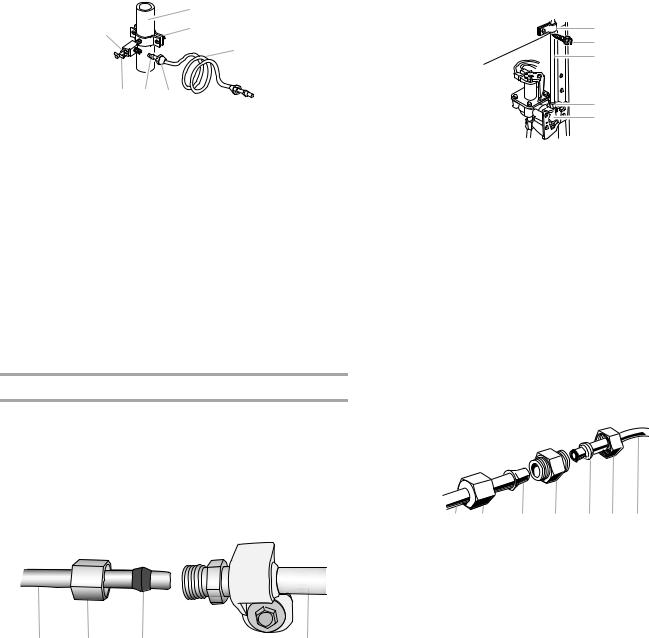
Style 2
1.Unplug refrigerator or disconnect power.
2.Turn OFF main water supply. Turn ON nearest faucet long enough to clear line of water.
3.Locate a ¹⁄ " (1.27 cm) to 1¹⁄ " (3.18 cm) vertical cold water pipe near the refrigerator.
IMPORTANT:
■Make sure it is a cold water pipe.
■Horizontal pipe will work, but drill on the top side of the pipe, not the bottom. This will help keep water away from the drill and normal sediment from collecting in the valve.
4.Determine the length of copper tubing you need. Measure from the connection on the lower rear corner of refrigerator to the water pipe. Add 7 ft (2.1 m) to allow for cleaning. Use ¹⁄ " (6.35 mm) O.D. (outside diameter) copper tubing. Be sure both ends of copper tubing are cut square.
5.Using a cordless drill, drill a ¹⁄ " (6.35 mm) hole in the cold water pipe you have selected.
|
A |
G |
B |
|
|
|
C |
F E |
D |
A. Cold water pipe |
E. Compression sleeve |
B. Pipe clamp |
F. Shutoff valve |
C. Copper tubing |
G. Packing nut |
D.Compression nut
6.Fasten the shutoff valve to the cold water pipe with the pipe clamp. Be sure the outlet end is solidly in the ¹⁄ " (6.35 mm) drilled hole in the water pipe and that the washer is under the pipe clamp. Tighten the packing nut. Tighten the pipe clamp screws slowly and evenly so the washer makes a watertight seal. Do not overtighten, or you may crush the copper tubing.
7.Slip the compression sleeve and compression nut on the copper tubing as shown. Insert the end of the tubing into the outlet end squarely as far as it will go. Screw the compression nut onto outlet end with adjustable wrench. Do not overtighten.
8.Place the free end of the tubing in a container or sink, and turn ON the main water supply. Flush the tubing until water is clear. Turn OFF the shutoff valve on the water pipe. Coil the copper tubing.
Connect to Refrigerator
Style 1
1.Unplug refrigerator or disconnect power.
2.Remove and discard the short, black plastic part from the end of the water line inlet.
3.Thread the nut onto the end of the tubing. Tighten the nut by hand. Then tighten it with a wrench two more turns. Do not overtighten.
NOTE: To avoid rattling, be sure the copper tubing does not touch the cabinet’s side wall or other parts inside the cabinet.
A |
B |
C |
D |
|
A. Household water line |
C. Ferrule (purchased) |
|
|
B. Nut (purchased) |
|
D. Refrigerator water tubing |
4.Install the water supply tube clamp around the water supply line to reduce strain on the coupling.
5.Turn shutoff valve ON.
6.Check for leaks. Tighten any connections (including connections at the valve) or nuts that leak.
Style 2
1.Unplug refrigerator or disconnect power.
2.Remove and discard the plastic part that is attached to the inlet of the water valve.
3.Attach the copper tube to the valve inlet using a compression nut and sleeve as shown. Tighten the compression nut. Do not overtighten.
4.Use the tube clamp on the back of the refrigerator to secure the tubing to the refrigerator as shown. This will help avoid damage to the tubing when the refrigerator is pushed back against the wall.
5.Turn shutoff valve ON.
6.Check for leaks. Tighten any connections (including connections at the valve) or nuts that leak.
A
B
C
D
E
A. Tube clamp |
D. Compression nut |
B. Tube clamp screw |
E. Valve inlet |
C.Copper tubing
7.On some models, the ice maker is equipped with a built-in water strainer. If your water conditions require a second water strainer, install it in the ¹⁄ " (6.35 mm) water line at either tube connection. Obtain a water strainer from your nearest appliance dealer.
Style 3
1.Unplug refrigerator or disconnect power.
2.Remove and discard the black nylon plug from the gray water tube on the rear of the refrigerator.
3.If the gray water tube supplied with the refrigerator is not long enough, a ¹⁄ " x ¹⁄ " (6.35 mm x 6.35 mm) coupling is needed in order to connect the water tubing to an existing household water line. Thread the provided nut onto the coupling on the end of the copper tubing.
NOTE: Tighten the nut by hand. Then tighten it with a wrench two more turns. Do not overtighten.
A |
B |
C |
D |
E F G |
A. Refrigerator water tubing |
|
E. Ferrule (purchased) |
||
B. Nut (provided) |
|
|
F. Nut (purchased) |
|
C. Bulb |
|
|
|
G. Household water line |
D.Coupling (purchased)
4.Turn shutoff valve ON.
5.Check for leaks. Tighten any nuts or connections (including connections at the valve) that leak.
9
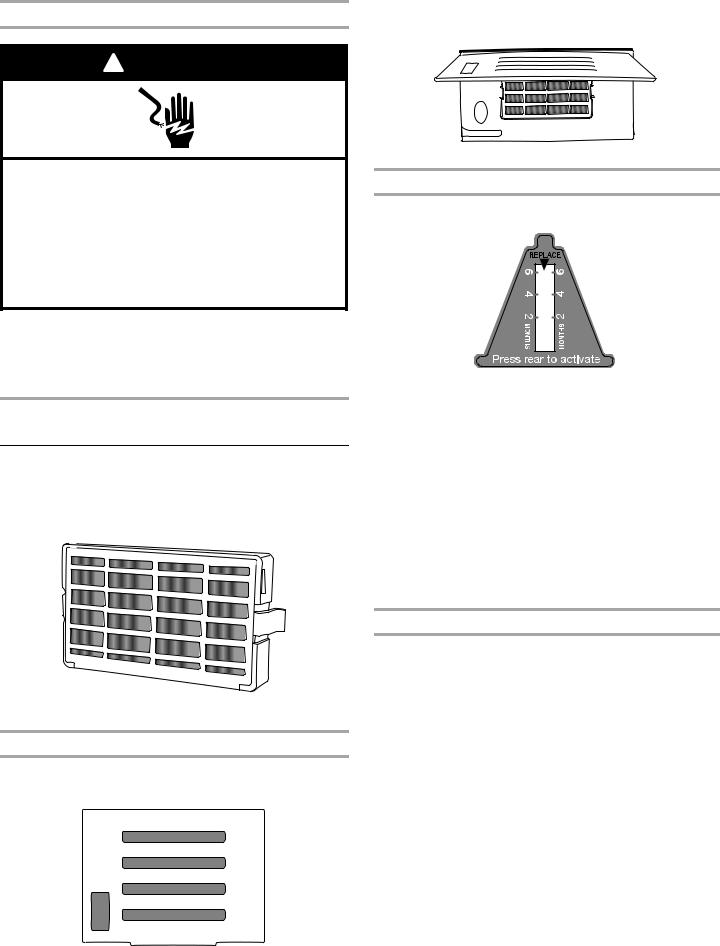
Complete the Installation
 WARNING
WARNING
Electrical Shock Hazard
Plug into a grounded 3 prong outlet.
Do not remove ground prong.
Do not use an adapter.
Do not use an extension cord.
Failure to follow these instructions can result in death, fire, or electrical shock.
1.Plug into a grounded 3 prong outlet.
2.Flush the water system. See “Water and Ice Dispensers” in the User Instructions or User Guide.
NOTE: Allow 24 hours to produce the first batch of ice. Allow 72 hours to completely fill ice container.
FILTERS AND ACCESSORIES
Install Air Filter
(on some models)
On some models, your refrigerator's accessory packet includes an air filter, which must be installed prior to use. On some models, the air filter is already installed at the factory.
The air filter reduces the buildup of odors. This helps to maintain a cleaner environment inside the refrigerator.
Installing the Air Filter (on some models)
The filter should be installed behind the vented door, which is located (depending on your model) along either the rear or left interior wall near the top of the refrigerator compartment.
1.Remove the air filter from its packaging.
2.Lift open the vented door.
3.Snap the filter into place.
4.Close the vented door.
Installing the Filter Status Indicator (on some models)
The filter comes with a status indicator, which should be activated and installed at the same time the air filter is installed.
1.Place the indicator face-down on a firm, flat surface.
2.Apply pressure to the bubble on the back of the indicator, until the bubble pops to activate the indicator.
3.Lift open the vented air filter door. On some models, there are notches behind the door.
4.On models with notches:
■Slide the indicator down into the notches, facing outward.
NOTE: The indicator will not easily slide into the notches if the rear bubble has not been popped.
■Close the air filter door, and check that the indicator is visible through the rectangular hole in the door.
On models without notches:
■Store the indicator in a visible place you will easily remember - either inside the refrigerator, or elsewhere in your kitchen or home.
Replacing the Air Filter
The disposable air filter should be replaced every 6 months, when the status indicator has completely changed from white to red.
To order a replacement air filter, see “Accessories” in the User Instructions or User Guide.
1.Remove the old air filter by squeezing in on the side tabs.
2.Remove the old status indicator.
3.Install the new air filter and status indicator using the instructions in the previous sections.
10
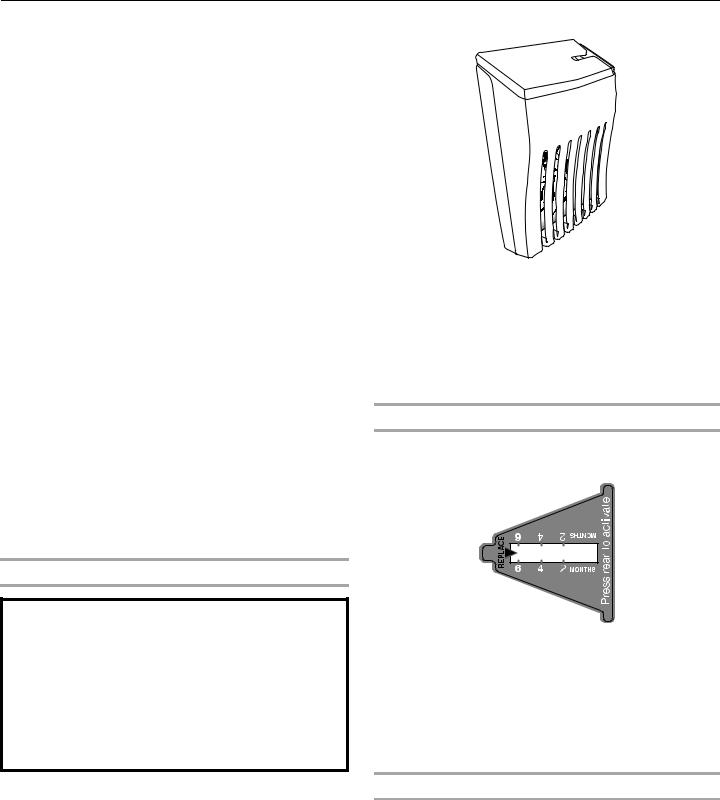
Install Produce Preserver (on some models)
On some models, your refrigerator's accessory packet includes a Produce Preserver, which should be installed prior to use. On some models, the Produce Preserver is already installed at the factory.
The Produce Preserver absorbs ethylene, allowing the ripening process of many produce items to slow down. As a result, certain produce items will stay fresh longer.
Ethylene production and sensitivity varies depending on the type of fruit or vegetable. To preserve freshness, it is best to separate produce with sensitivity to ethylene from fruits that produce moderate to high amounts of ethylene.
|
Sensitivity to |
Ethylene |
|
Ethylene |
Production |
|
|
|
Apples |
High |
Very High |
|
|
|
Asparagus |
Med. |
Very Low |
|
|
|
Berries |
Low |
Low |
|
|
|
Broccoli |
High |
Very Low |
|
|
|
Cantaloupe |
Med. |
High |
|
|
|
Carrots |
Low |
Very Low |
|
|
|
Citrus Fruit |
Med. |
Very Low |
|
|
|
Grapes |
Low |
Very Low |
|
|
|
Lettuce |
High |
Very Low |
|
|
|
Pears |
High |
Very High |
|
|
|
Spinach |
High |
Very Low |
|
|
|
Installing the Produce Preserver (on some models)
CAUTION: IRRITANT
MAY IRRITATE EYES AND SKIN. DANGEROUS FUMES FORM WHEN MIXED WITH OTHER PRODUCTS.
Do not mix with cleaning products containing ammonia, bleach or acids. Do not get in eyes, on skin or clothing. Do not breathe dust. Keep out of reach of children.
FIRST AID TREATMENT: Contains potassium permanganate. If swallowed, call a Poison Control Center or doctor immediately. Do not induce vomiting. If in eyes, rinse with water for 15 minutes. If on skin, rinse with water.
The Produce Preserver pouches should be installed in their housing, which is located along an interior side wall of the crisper or convertible drawer.
NOTE: For best performance, always use two pouches.
1.Remove the Produce Preserver pouches from their packaging.
2.Lift up on the housing in order to remove it from its mounting tab along the wall.
3.Open the housing by pulling up and out on the back of the top of the housing.
4.Place both pouches inside the housing, then snap the housing back together.
5.Place the housing back on the mounting tab along the wall.
Installing the Status Indicator (on some models)
The Produce Preserver comes with a status indicator, which should be activated and installed at the same time the pouch is installed.
1.Place the indicator face-down on a firm, flat surface.
2.Apply pressure to the bubble on the back of the indicator, until the bubble pops to activate the indicator.
3.Slide open the cap on the Produce Preserver housing.
4.Place the indicator in the top of the housing, facing outward.
5.Slide the cap closed, and check that the indicator is visible through the rectangular hole in the cap.
NOTE: The cap will not easily close if the indicator’s rear bubble has not been popped.
Replacing the Produce Preserver (on some models)
The disposable pouches should be replaced every 6 months, when the status indicator has completely changed from white to red.
To order replacements, see “Accessories” in the User Instructions or User Guide.
1.Remove the old pouches from the Produce Preserver housing.
2.Remove the old status indicator.
3.Install the new pouches and status indicator using the instructions in the previous sections.
11
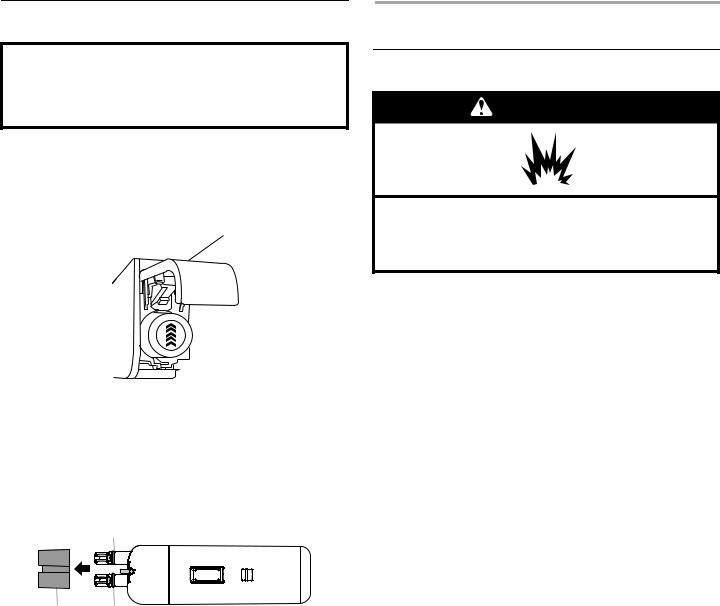
Changing the Water Filter
Do not use with water that is microbiologically unsafe or of unknown quality without adequate disinfection before or after the system. Systems certified for cyst reduction may be used on disinfected waters that may contain filterable cysts.
The water filter status light will help you know when to change your water filter. See “Water Filtration System” in the User Instructions or User Guide.
NOTE: If water flow to your water dispenser or ice maker decreases noticeably, change the filter sooner. The filter should be replaced at least every 6 months, depending on your water quality and usage.
1.Locate the water filter in the top-right corner of the refrigerator compartment.
2.Lift open the filter cover door. The filter will be released and then be ejected as the door is opened.
3.When the door is completely open, pull the filter straight out.
NOTE: There may be some water in the filter. Some spilling may occur. Use a towel to wipe up any spills.
4.Take the new filter out of its packaging and remove the cap. Be sure the O-rings are still in place after the cap is removed.
B
A B
A. Cap |
B. O-rings |
5.With the arrow pointing up, align the new filter with the filter housing and slide it into place. The filter cover door will automatically begin to close as the new filter is inserted.
6.Close the filter cover door completely in order to snap the filter into place. You may need to press hard.
7.After changing the filter, reset the filter status light. See “Water Filtration System” in the User Instructions or User Guide.
8.Flush the water system. See “Water and Ice Dispensers” in the User Instructions or User Guide.
REFRIGERATOR CARE
Cleaning
WARNING
Use nonflammable
Failure to do so can result in death, explosion, or fire.
Both the refrigerator and freezer sections defrost automatically. However, clean both sections about once a month to avoid buildup of odors. Wipe up spills immediately.
IMPORTANT: Because air circulates between both sections, any odors formed in one section will transfer to the other. You must thoroughly clean both sections to eliminate odors. To avoid odor transfer and drying out of food, wrap or cover foods tightly.
To Clean Your Refrigerator:
NOTE: Do not use abrasive or harsh cleaners such as window sprays, scouring cleansers, flammable fluids, cleaning waxes, concentrated detergents, bleaches or cleansers containing petroleum products on plastic parts, interior and door liners or gaskets. Do not use paper towels, scouring pads, or other harsh cleaning tools.
1.Unplug refrigerator or disconnect power.
2.Hand wash, rinse, and dry removable parts and interior surfaces thoroughly. Use a clean sponge or soft cloth and a mild detergent in warm water.
3.Wash stainless steel and painted metal exteriors with a clean sponge or soft cloth and a mild detergent in warm water.
4.There is no need for routine condenser cleaning in normal home operating environments. If the environment is particularly greasy or dusty, or there is significant pet traffic in the home, the condenser should be cleaned every 2 to
3 months to ensure maximum efficiency. If you need to clean the condenser:
■Remove the base grille. See the “Door Removal” instructions, either in the User Instructions or the Installation Instructions and Owner’s Manual, or in the separate instruction sheet provided with your refrigerator.
■Use a vacuum cleaner with a soft brush to clean the grille, the open areas behind the grille and the front surface area of the condenser.
■Replace the base grille when finished.
5.Plug in refrigerator or reconnect power.
12
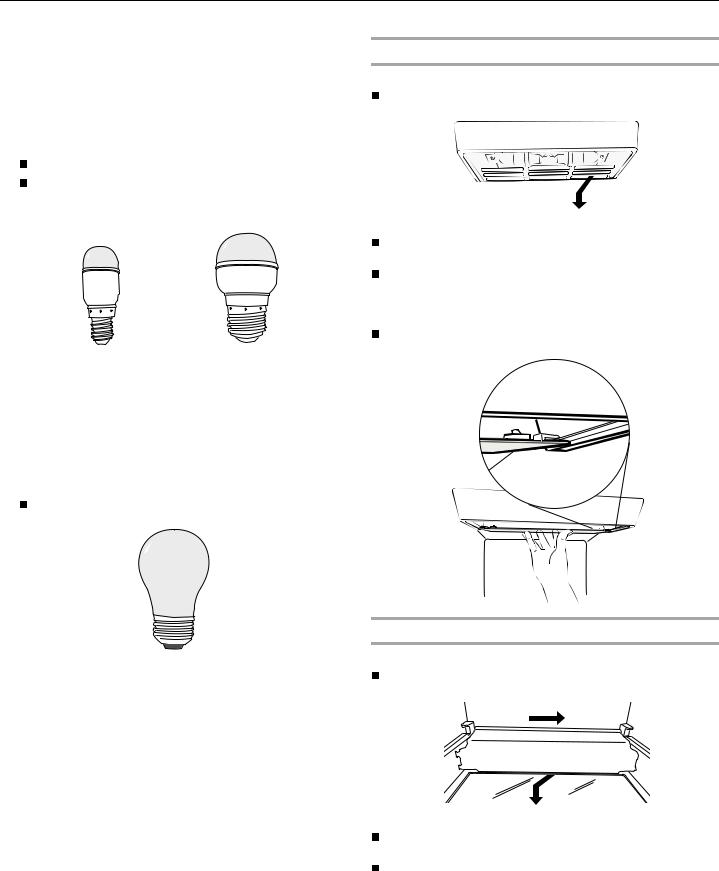
Lights
IMPORTANT: The refrigerator and freezer compartments,
air tower and dispenser lights are LEDs that cannot be . changed by yourself. To order replacement LED lightings, please, call Whirlpool service (1-800-253-1301 (U.S.A.) or
1-800-807-6777 (Canada).)
Light Styles:
The dispenser lights are mini LEDs that cannot be changed. The interior lights vary by model.
Some models have mini LEDs that cannot be changed.
Some models have full-size LED bulbs that can be changed. To order replacement LED bulbs, call
1-800-253-1301 (U.S.A.) or 1-800-807-6777 (Canada).
Whirlpool |
Whirlpool |
Part Number |
Part Number |
W10574850A |
W10565137A |
(2.0 watts) |
(3.6 watts) |
NOTE: Some LED replacement bulbs are not recommended for wet/damp environments. The refrigerator and freezer compartments are considered to be wet/damp environments. If using a brand of LED bulb other than the recommended Whirlpool LED bulb, read and follow all instructions on the replacement bulb’s packaging before installing it.
Some models have incandescent 40-watt bulbs that can be changed.
NOTE: Not all replacement bulbs will fit your refrigerator. Do not use an incandescent bulb in excess of 40 watts.
To Change a Light Bulb:
1.Unplug refrigerator or disconnect power.
2.Remove the light shield, as explained in the following sections.
NOTE: To clean the light shield, wash it with warm water and liquid detergent. Before reinstalling, thoroughly rinse and dry the shield.
3.Replace the burned-out light bulb, as explained in the following sections.
4.Reinstall the light shield, as explained in the following sections.
5.Plug in refrigerator or reconnect power.
Refrigerator Compartment - Upper Lights
Light Shield Removal:
Slide the light shield toward the rear of the refrigerator and remove it from the light housing.
Replacement Bulb:
If the burned-out light is a full-size LED bulb, replace it with Whirlpool part number W10574850A (a 2.0 watt LED bulb).
If the burned-out light is an incandescent bulb, replace it with an incandescent appliance bulb of the same size, shape and wattage (40-watt maximum).
Light Shield Reinstallation:
Align the light shield in the grooves at the bottom edge of the light housing, then slide it forward until it snaps into place.
Refrigerator Compartment - Lower Lights
Light Shield Removal:
Slide the light shield to the right to remove the left end from the wall slots, then pull the right end out of its wall slots.
Replacement Bulb:
If the burned-out light is a full-size LED bulb, replace it with Whirlpool part number W10565137A (a 3.6 watt LED bulb).
If the burned-out light is an incandescent bulb, replace it with an incandescent appliance bulb of the same size, shape and wattage (40-watt maximum).
13
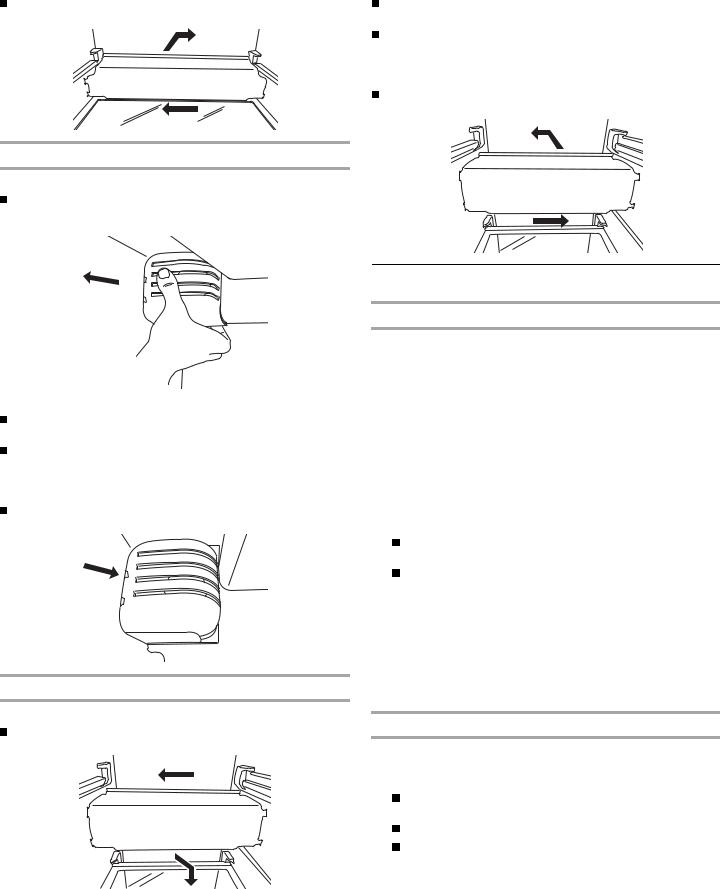
Light Shield Reinstallation:
Place the right end of the light shield into the wall slots, then snap the left end into its wall slots.
Freezer Compartment - Upper Light
Light Shield Removal:
Gently squeeze the front and the bottom-rear edge of the light shield to release the tabs from the wall slots, and then pull the light shield forward.
Replacement Bulb:
If the burned-out light is a full-size LED bulb, replace it with Whirlpool part number W10565137A (a 3.6 watt LED bulb).
If the burned-out light is an incandescent bulb, replace it with an incandescent appliance bulb of the same size, shape and wattage (40-watt maximum).
Light Shield Reinstallation:
Place the left end of the light shield into the wall slots, then snap the right end into its wall slots.
Replacement Bulb:
If the burned-out light is a full-size LED bulb, replace it with Whirlpool part number W10565137A (a 3.6 watt LED bulb).
If the burned-out light is an incandescent bulb, replace it with an incandescent appliance bulb of the same size, shape and wattage (40-watt maximum).
Light Shield Reinstallation:
Align the light shield in its proper position, and snap the tabs into the wall slots.
Freezer Compartment - Lower Light
Light Shield Removal:
Slide the light shield to the left to remove the right end from the wall slots, then pull the left end out of its wall slots.
Vacation and Moving Care
Vacations
If You Choose to Leave Refrigerator On While You Are Away:
1.Use up any perishables and freeze other items.
2.If your refrigerator has an automatic ice maker and is connected to the household water supply, turn off the water supply to the refrigerator. Property damage can occur if the water supply is not turned off.
3.If you have an automatic ice maker, turn off the ice maker.
NOTE: Depending on your model, raise the wire shutoff arm to OFF (up) position or press the switch to OFF.
4.Empty the ice bin.
If You Choose to Turn Refrigerator Off Before You Leave:
1.Remove all food from the refrigerator.
2.If your refrigerator has an automatic ice maker:
Turn off the water supply to the ice maker at least one day ahead of time.
When the last load of ice drops, raise the wire shutoff arm to the OFF (up) position or move the switch to the OFF setting.
3.Depending on the model, turn the Refrigerator Control to OFF or turn cooling off. See “Using the Controls” in the User Instructions, User Guide, or Use & Care Guide.
4.Clean, wipe, and dry thoroughly.
5.Tape rubber or wood blocks to the tops of both doors to prop them open far enough for air to get in. This stops odor and mold from building up.
Moving
When you are moving your refrigerator to a new home, follow these steps to prepare it for the move.
1. If your refrigerator has an automatic ice maker:
Turn off the water supply to the ice maker at least one day ahead of time.
Disconnect the water line from the back of the refrigerator.
When the last load of ice drops, raise the wire shutoff arm to the OFF (up) position or move the switch to the OFF setting.
2.Remove all food from the refrigerator and pack all frozen food in dry ice.
3.Empty the ice bin.
14
